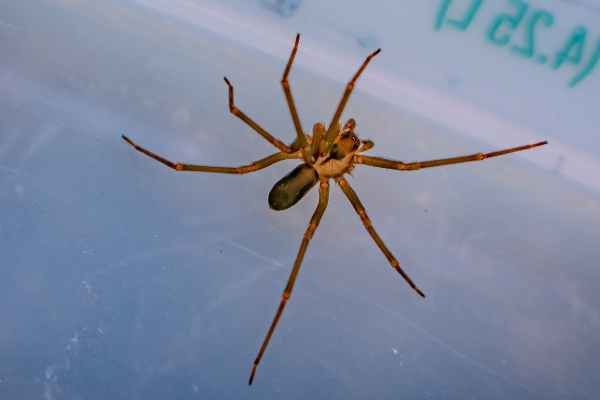 The brown recluse, Loxosceles reclusa, Sicariidae (formerly placed in a family “Loxoscelidae”) is a recluse spider with a necrotic venom. Similar to other recluse spider bites, their bite sometimes requires medical attention. The brown recluse is one of three spiders (the others being the black widow and Loxosceles laeta, the Chilean recluse) with medically significant venom in North America.
The brown recluse, Loxosceles reclusa, Sicariidae (formerly placed in a family “Loxoscelidae”) is a recluse spider with a necrotic venom. Similar to other recluse spider bites, their bite sometimes requires medical attention. The brown recluse is one of three spiders (the others being the black widow and Loxosceles laeta, the Chilean recluse) with medically significant venom in North America.
Brown recluse spiders are usually between 6 and 20 millimetres (0.24 and 0.79 in), but may grow larger. While typically light to medium brown, they range in color from whitish to dark brown or blackish gray. The cephalothorax and abdomen are not necessarily the same color. These spiders usually have markings on the dorsal side of their cephalothorax, with a black line coming from it that looks like a violin with the neck of the violin pointing to the rear of the spider, resulting in the nicknames fiddleback spider, brown fiddler, or violin spider.
The violin pattern is not diagnostic, as other spiders can have similar markings (e.g. cellar spiders and pirate spiders). For definitive identification, it is imperative to examine the eyes. The reason for this is because the brown recluse spider is in the haplogynae bifurcation of the araneomorphae infraorder. While most spiders have eight eyes, recluse spiders have six eyes arranged in pairs (dyads) with one median pair and two lateral pairs. The brown recluse’s violin marking can vary in intensity depending on the age of the spider, with mature spiders typically having dark violin shapes. The violin shape points toward the spider’s bulbous abdomen. The violin shape is easy to misinterpret, so it is best to look at the eyes when determining if a spider is a brown recluse. Only a few other spiders have three pairs of eyes arranged in this way (e.g., scytodids). Recluses have no obvious coloration patterns on the abdomen or legs, and the legs lack spines. The abdomen is covered with fine short hairs that, when viewed without magnification, give the appearance of soft fur. The leg joints may appear to be a slightly lighter color.
Life-cycle
Adult brown recluse spiders often live about one to two years. Each female produces several egg sacs over a period of two to three months, from May to July, with approximately fifty eggs in each sac. The eggs hatch in about one month. The spiderlings take about one year to grow to adulthood. The brown recluse spider is resilient and can tolerate up to six months of extreme drought and scarcity or absence of food. On one occasion, a brown recluse survived in controlled captivity for over five seasons without any food at all.
As part of the haplogynae, brown recluse do not balloon, which limits its ability to widely disperse geographically. The brown recluse will, though not habitually, cannibalize another if food becomes scarce; especially during its typical mating season from June to September or when an unreceptive female encounters an aggressive male.
A brown recluse’s stance on a flat surface is usually with all legs radially extended. When alarmed it may lower its body, withdraw the forward two legs straight rearward into a defensive position, withdraw the rearmost pair of legs into a position for lunging forward, and stand motionless with pedipalps raised. The pedipalps in mature specimens are dark and quite prominent and are normally held horizontally forward. When threatened it usually flees, seemingly to avoid a conflict, and if detained may further avoid contact with quick horizontal rotating movements or even resort to assuming a lifeless pose (playing dead). The spider does not usually jump unless touched brusquely, and even then its avoidance movement is more of a horizontal lunge rather than a vaulting of itself entirely off the surface. When running, the brown recluse does not leave a silk line behind, which would make it more easily tracked when it is being pursued. Movement at virtually any speed is an evenly paced gait with legs extended.
The brown recluse spider displays autotomy as a defense mechanism against physical, predatory attack to a leg as well as to prevent predatory, venom injections from spreading to the rest of the body. “Once a leg is lost, a recluse spider does not regenerate a new one with subsequent molts”, unlike the huntsman spider that does regenerate autotomized legs. With each time that a leg is autotomized, the recluse “changes its gait to compensate for the loss.” During travel, it stops naturally and periodically when renewing its internal hydraulic blood pressure that it, like most spiders, requires to renew strength in its legs.
Habitat
Brown recluse spiders build asymmetrical (irregular) webs that frequently include a shelter consisting of disorderly threads. They frequently build their webs in woodpiles and sheds, closets, garages, plenum spaces, cellars, and other places that are dry and generally undisturbed. When dwelling in human residences they seem to favor cardboard, possibly because it mimics the rotting tree bark which they inhabit naturally. Human-recluse contact often occurs when such isolated spaces are disturbed and the spider feels threatened. Unlike most web weavers, they leave these lairs at night to hunt. Males move around more when hunting than the females, which tend to remain nearer to their webs.
Source: Wikipedia





